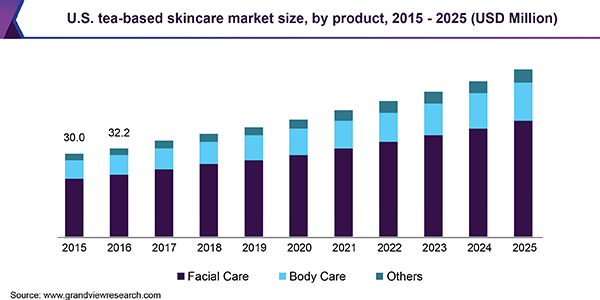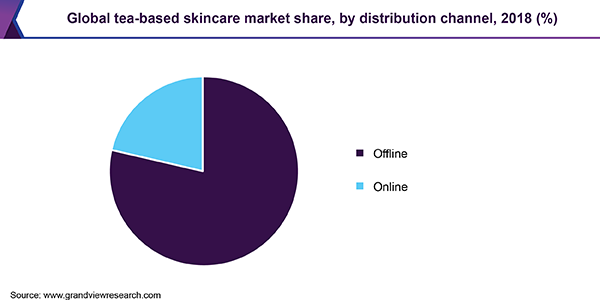- Home
- »
- Beauty & Personal Care
- »
-
Tea-based Skin Care Market Size, Share, Industry Report, 2019-2025GVR Report cover
![Tea-based Skin Care Market Size, Share & Trends Report]()
Tea-based Skin Care Market Size, Share & Trends Analysis Report By Product (Facial Care, Body Care), By Distribution Channel (Offline, Online), By Region, And Segment Forecasts, 2019 - 2025
- Report ID: GVR-3-68038-670-7
- Number of Report Pages: 80
- Format: PDF, Horizon Databook
- Historical Range: 2015 - 2017
- Forecast Period: 2019 - 2025
- Industry: Consumer Goods
Industry Insights
The global tea-based skincare market size was valued at USD 168.2 million in 2018 and is anticipated to expand at a CAGR of 7.5% during the forecast period. Rising awareness regarding the antioxidant, anti-inflammatory, and anti-aging properties of tea extract are expected to drive its application in cosmetics and skincare products. This factor is projected to fuel market growth. Moreover, rising awareness regarding vegan beauty products in light of growing socio-economic concerns over animal will further drive the growth.
Tea contains a high concentration of antioxidants, vitamin B, vitamin E, caffeine, tannin, folate, potassium, manganese, and magnesium. These ingredients prevent and delay the signs of aging and improve the appearance of the skin. Vitamin E promotes cell regeneration, hydration, and nourishment. Tannins control sebum production and help treat oily skin. As a result, tea extract is used as an active ingredient in various skin care formulations. All these factors are anticipated to drive the demand for tea-based skincare products in near future.

Different types of tea including white, spearmint, oolong, hibiscus, and green are majorly used for tea-based skincare products. White tea extract helps retain moisture and prevent damage caused by sun exposure. Spearmint, oolong, and hibiscus tea help reduce skin problems, such as acne, eczema, and clogged pores. Green tea is the most popular ingredient used in the cosmetics industry owing to its antioxidant, anti-inflammatory, and antibacterial properties.
Rising consumer preference for natural or organic beauty products is expected to bode well for the tea-based skincare market. The demand is driven by rising environmental awareness and concerns about the harmful effects of synthetic cosmetics. Furthermore, factors such as rapid urbanization and increasing purchasing power of the middle-class population in emerging economies like China, India, and Brazil, are anticipated to fuel the demand for tea-based skincare products in near future.
Product Insights
The facial skincare product segment held the largest market share of more than 65% in 2018. Face cream, moisturizer, cleanser, toner, mask, serum, sun care, and mist are among the popular products in this category. Rising demand for tea-based facemasks is anticipated to bode well for the segment growth. These facemasks are rich with antioxidants and vitamin B-2 that help reduce signs of aging and maintain collagen levels and firmness of the skin.
Rising demand for natural and organic products is anticipated to fuel the demand for tea-based skincare products. Manufacturers focus on expanding their product portfolio by introducing products such as body soap, body wash, lotion, and oil. For instance, in July 2018, Schmidt's Naturals, a U.S. based body care brand, launched its Jasmine Tea Body Wash.
Distribution Channel Insights
The offline distribution channel held the largest market share of over 75% in 2018. Supermarkets and specialty stores contributed to the majority of sales of the offline retail outlets. Consumers prefer brick and mortar stores as they can physically view the products before buying. It also allows product testing and assistance from brand representatives. This factor is anticipated to drive the segment growth over the forecast period.

On the other hand, the online distribution channel segment is projected to witness the fastest CAGR of 6.0% from 2019 to 2025. Convenience is the major driving factor for the segment. These websites offer a wide range of products, easy comparison and selection based on specific customer needs, and attractive discounts. Quick product delivery is also anticipated to bode well for the segment growth. Major e-retailers of tea-based skincare products include Amazon; Sephora; Ulta Beauty, Inc.; Strawberrynet; and Feelunique International Limited.
Regional Insights
The Asia Pacific held the leading market share of more than 30% in terms of revenue in 2018. The use of natural and organic ingredients in beauty products has gained remarkable traction in this region. South Korea, China, Japan, Hong Kong, Singapore, India, Taiwan, and Thailand are the prominent markets in the Asia Pacific. The presence of key manufacturers, including AmorePacific Corporation, Lu Ming Tang, SkinYoga, Organic Tea Cosmetics Holdings Co Ltd., and Soh-cha, has played a crucial role in promoting product visibility in the region. The Asia Pacific has a long history of tea culture, which has boosted the production sector due to the easy availability of raw material. Green tea is the most popular ingredient used in the tea-based skincare products manufactured in the region. More than half of the tea-based skin care products in China contain green tea. White and green tea extracts are gaining significant popularity in Japan.
Tea-Based Skincare Market Share Insights
The tea-based skincare market is fragmented in nature with the presence of a large number of small and local producers and a few large players. Major competitors operating in the market include AmorePacific Corporation; Lu Ming Tang; Organic Tea Cosmetics Holdings Co Ltd.; Natura & Co; L'Oréal S.A.; Avon Products, Inc.; Unilever; 100% PURE; SkinYoga; Schmidt's Naturals; and ArtNaturals. Leading cosmetics companies have been expanding their product portfolio to cater to the rising demand for organic and tea-based skincare products. For instance, in June 2019, Unilever acquired Tatcha LLC, a Japan-based modern skincare brand to expand its natural product segment.
Report Scope
Attribute
Details
The base year for estimation
2018
Actual estimates/Historical data
2015 - 2017
Forecast period
2019 - 2025
Market representation
Revenue in USD Million and CAGR from 2019 to 2025
Regional scope
North America, Europe, Asia Pacific, Central & South America, Middle East & Africa
Country scope
U.S., Germany, U.K., China, South Korea, Brazil, Saudi Arabia
Report coverage
Revenue forecast, company share, competitive landscape, and growth factors and trends
15% free customization scope (equivalent to 5 analyst working days)
If you need specific market information, which is not currently within the scope of the report, we will provide it to you as a part of customization
Segments Covered in the ReportThis report forecasts revenue growth at global, regional, and country levels, and provides an analysis of the latest industry trends in each of the sub-segments from 2015 to 2025. For this study, Grand View Research has segmented the global tea-based skincare market report based on the product, distribution channel, and region.
-
Product Outlook (Revenue, USD Million, 2015 - 2025)
-
Facial Care
-
Body Care
-
Others
-
-
Distribution Channel Outlook (Revenue, USD Million, 2015 - 2025)
-
Online
-
Offline
-
-
Region Outlook (Revenue, USD Million, 2015 - 2025)
-
North America
-
The U.S.
-
-
Europe
-
Germany
-
U.K.
-
-
Asia Pacific
-
China
-
South Korea
-
-
Central & South America
-
Brazil
-
-
Middle East & Africa
-
Saudi Arabia
-
-
Share this report with your colleague or friend.
![gvr icn]()
NEED A CUSTOM REPORT?
We can customize every report - free of charge - including purchasing stand-alone sections or country-level reports, as well as offer affordable discounts for start-ups & universities. Contact us now
![Certified Icon]()
We are GDPR and CCPA compliant! Your transaction & personal information is safe and secure. For more details, please read our privacy policy.
We are committed towards customer satisfaction, and quality service.
"The quality of research they have done for us has been excellent."





